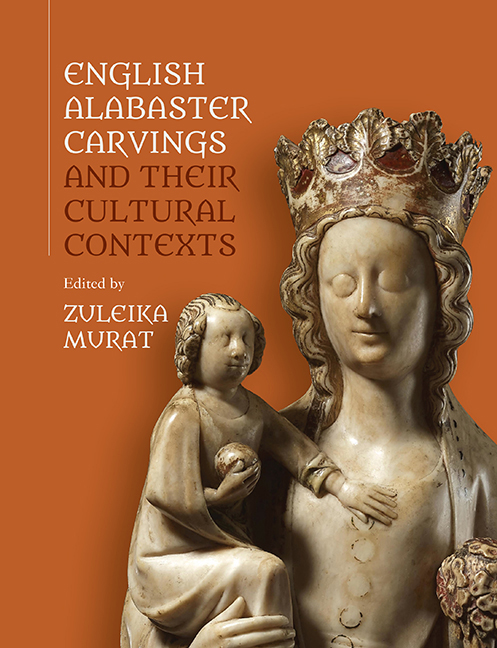Book contents
- Frontmatter
- CONTENTS
- List of Illustrations
- Acknowledgements
- List of Contributors
- Introduction
- 1 ‘Burton-Upon-Trent, Not Nottingham.’ the Evolving Study Of Medieval English Alabaster Sculpture
- 2 Stone to Ensure Victory and to Generate Friendships. On The Meaning of Alabaster
- 3 Contextualising English Alabasters in the Material Culture of the Medieval Mediterranean
- 4 English Alabaster Images As Recipients of Music in the Long Fifteenth Century: English Sacred Traditions in a European Perspective
- 5 Contextualising Alabasters in Their Immersive Environment. The ‘Ancona D'Allabastro Di Diverse Figure’ of the Novalesa Abbey: Meaning and Function
- 6 Alabaster Carvings in Late-Medieval Lincolnshire
- 7 ‘Tabernacles, Howsynges and Other Things’. Three Alabasters From the Burrell Collection in Context
- 8 Conservation Study of Three Alabaster Carvings From the Burrell Collection, Glasgow Museums
- 9 ‘Smooth as Monumental Alabaster’. the Alabaster Tomb Industry in England 1550–1660
- 10 Merchants’ Tombs in Alabaster
- 11 Exploring Alice: the Theological, Socio-Historical, and Anatomical Context of the De La Pole Cadaver Sculpture
- Bibliography
- Index
- Already Published
5 - Contextualising Alabasters in Their Immersive Environment. The ‘Ancona D'Allabastro Di Diverse Figure’ of the Novalesa Abbey: Meaning and Function
Published online by Cambridge University Press: 14 September 2019
- Frontmatter
- CONTENTS
- List of Illustrations
- Acknowledgements
- List of Contributors
- Introduction
- 1 ‘Burton-Upon-Trent, Not Nottingham.’ the Evolving Study Of Medieval English Alabaster Sculpture
- 2 Stone to Ensure Victory and to Generate Friendships. On The Meaning of Alabaster
- 3 Contextualising English Alabasters in the Material Culture of the Medieval Mediterranean
- 4 English Alabaster Images As Recipients of Music in the Long Fifteenth Century: English Sacred Traditions in a European Perspective
- 5 Contextualising Alabasters in Their Immersive Environment. The ‘Ancona D'Allabastro Di Diverse Figure’ of the Novalesa Abbey: Meaning and Function
- 6 Alabaster Carvings in Late-Medieval Lincolnshire
- 7 ‘Tabernacles, Howsynges and Other Things’. Three Alabasters From the Burrell Collection in Context
- 8 Conservation Study of Three Alabaster Carvings From the Burrell Collection, Glasgow Museums
- 9 ‘Smooth as Monumental Alabaster’. the Alabaster Tomb Industry in England 1550–1660
- 10 Merchants’ Tombs in Alabaster
- 11 Exploring Alice: the Theological, Socio-Historical, and Anatomical Context of the De La Pole Cadaver Sculpture
- Bibliography
- Index
- Already Published
Summary
It is now universally recognised just how important it is to restore a work of art to its original context – a term taken broadly to mean historical, spatial, liturgical and functional context – if we are to gain a precise understanding of it. The study of context is really a fundamental point of departure for analysis, the basic premise for each new study, since it is context that allows the scholar to establish the full suite of meanings proposed by a work – meanings which have often been stripped away over the course of time, especially in the case of museum-displayed objects – and indeed a sense of the agency that a work may have had at the moment of its creation. The understanding of context thus provides the necessary interpretive structure: without it, a work would simply float in an a-historic and impersonal non-place, reduced to a shell that, even if still appreciable in some sense, has been emptied of its substance.
A methodology of this type, however, encounters serious difficulties when applied to the study of English alabasters. Only a few alabaster works remain in their original location, and of the examples that have been re-located (either relegated to museums or sent to a new location after the Reformation), often little is known of their provenance or history. These difficulties apply especially to English alabasters found in Italy, as these are works which appear doubly out of context. Not only are they often fragmentary objects displayed in museums, they are also works produced by an “other” culture, appearing then to modern viewers as incongruous presences, alien to the place in which they are found.
The modern status of these objects, however, contrasts greatly with the high value given to them in the past. In Italy alone, there are more than thirty reliefs, a clear indication of the high regard in which these objects were once held. This prestige is further confirmed by the knowledge that many pieces – the polyptych now in Naples (still intact), the polyptych in Ferrara, and the fragments in Milan – originally decorated the private chapels of the lords of those cities. Sculptures now conserved in Rome, meanwhile, were commissioned by no lesser man than the Pope's representative in England, to be placed in the Roman church of Santa Croce in Gerusalemme.
- Type
- Chapter
- Information
- English Alabaster Carvings and their Cultural Contexts , pp. 127 - 149Publisher: Boydell & BrewerPrint publication year: 2019



